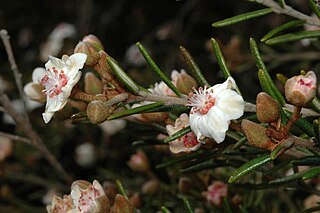
Ricinocarpos bowmanii, commonly known as western wedding bush or Bowman jasmine, is a species of flowering plant in the family Euphorbiaceae and is endemic to New South Wales. It is usually a monoecious shrub with linear to oblong leaves and three to six male flowers around each female flower.
Ricinocarpos brevis is a species of flowering plant in the family Euphorbiaceae and is endemic to inland Western Australia. It is a monoecious, densely-branched shrub with narrowly oblong leaves and male and female flowers arranged singly or in small groups.
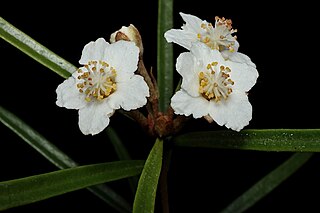
Ricinocarpos caniana is a species of flowering plant in the family Euphorbiaceae and is endemic to a restricted area of south-eastern Queensland. It is an erect monoecious or dioecious shrub with linear leaves and white flowers, arranged either singly, with two to five male flowers, or a single female flower surrounded by up to four male flowers.
Ricinocarpos crispatus is a species of flowering plant in the family Euphorbiaceae and is endemic to south-western Queensland. It is a monoecious or dioecious shrub with linear leaves and white flowers, arranged either singly, with two to four male flowers, or a single female flower surrounded by one or two male flowers.
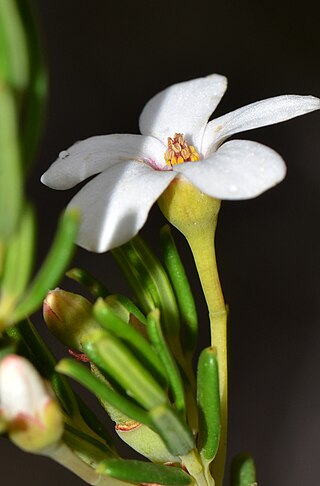
Ricinocarpos cyanescens is a species of flowering plant in the family Euphorbiaceae and is endemic to the south-west of Western Australia. It is a compact, monoecious shrub with narrowly oblong leaves and male and female flowers arranged singly or in small groups.
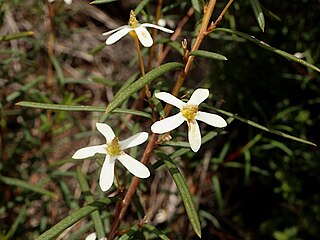
Ricinocarpos glaucus is a species of flowering plant in the family Euphorbiaceae and is endemic to the south-west of Western Australia. It is an erect, monoecious or dioecious shrub with linear or narrowly oblong leaves and male and female flowers arranged singly or in small groups.
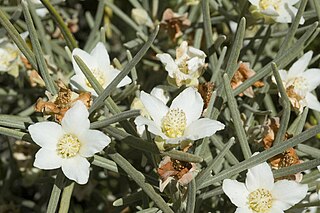
Ricinocarpos gloria-medii is a species of flowering plant in the family Euphorbiaceae and is endemic to the Northern Territory of Australia. It is a spreading, monoecious or dioecious shrub with linear leaves and male and female flowers arranged singly or in small groups.
Ricinocarpos graniticus is a species of flowering plant in the family Euphorbiaceae and is endemic to the southwest of Western Australia. It is a monoecious shrub with linear leaves and creamy white flowers, arranged either singly, or with a single female flower surrounded by one or two male flowers.
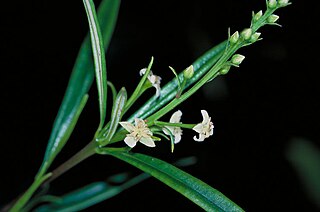
Ricinocarpos ledifolius is a species of flowering plant in the family Euphorbiaceae and is endemic to eastern Queensland. It is a monoecious or dioecious shrub or small tree with linear leaves and white flowers, arranged either singly, or with two or three female or two to six male flowers, or a single female flower surrounded by two male flowers.

Ricinocarpos linearifolius is a species of flowering plant in the family Euphorbiaceae and is endemic to eastern Australia. It is a monoecious or dioecious shrub with hairy young branchlets, linear leaves and white flowers, arranged either singly, with two to four male flowers, or a single female flower surrounded by up to three male flowers.
Ricinocarpos marginatus is a species of flowering plant in the family Euphorbiaceae and is endemic to the north-west of Western Australia. It is an erect, monoecious shrub with narrowly elliptic leaves and white flowers arranged in groups of male flowers, or up to three female flowers surrounded by many male flowers.
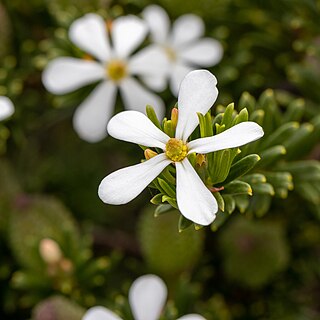
Ricinocarpos megalocarpus is a species of flowering plant in the family Euphorbiaceae and is endemic to the south coast of Western Australia. It is a compact, rounded, usually monoecious shrub with linear leaves and white flowers, arranged either singly, or male flowers in groups, or with a single female flower surrounded by up to six male flowers.
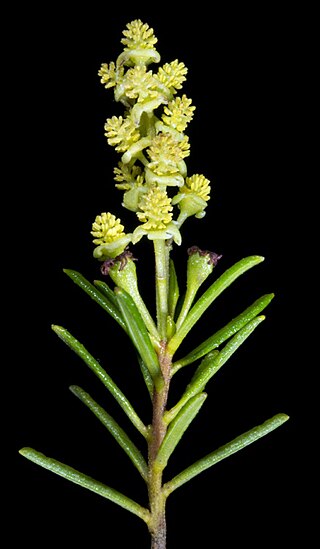
Ricinocarpos muricatus is a species of flowering plant in the family Euphorbiaceae and is endemic to the south-west of Western Australia. It is an erect to spreading, sticky, monoecious shrub with linear leaves and yellow flowers arranged in a raceme, with one or two female flowers surrounded by 8 to 12 male flowers.
Ricinocarpos oliganthus is a species of flowering plant in the family Euphorbiaceae and is endemic to a small area in the south-west of Western Australia. It is a monoecious shrub with linear to narrowly oblong leaves and white to creamy white flowers arranged singly on the ends of branchlets.
Ricinocarpos pilifer is a species of flowering plant in the family Euphorbiaceae and is endemic to a small area in the south-west of Western Australia. It is a compact monoecious shrub with narrowly oblong leaves and creamy white flowers arranged singly, or with two to four male flowers, or a single female flower with one or two male flowers.
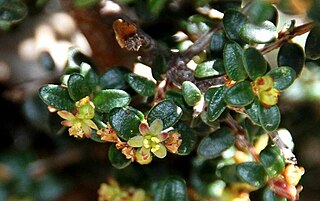
Pseudanthus orbicularis is a species of flowering plant in the family Picrodendraceae and is endemic to south-eastern continental Australia. It is a compact, monoecious shrub with simple, broadly elliptic to round leaves and creamy white, red or pale red flowers arranged singly in upper leaf axils.
Stachystemon mucronatus is a species of flowering plant in the family Picrodendraceae and is endemic to the south-west of Western Australia. It is a compact, monoecious shrub with narrowly oblong or narrowly elliptic leaves and small, greenish yellow flowers arranged singly in upper leaf axils.
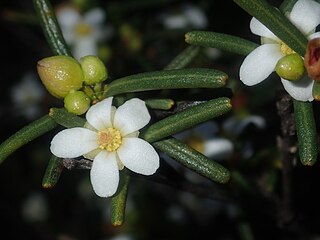
Ricinocarpos psilocladus is a species of flowering plant in the family Euphorbiaceae and is endemic to the west coast of Western Australia. It is an erect, open, monoecious or dioecious shrub with linear to narrowly oblong or narrowly egg-shaped leaves, and white or yellow flowers arranged singly, or with two to five male flowers, or a single female flower surrounded by up to three male flowers.
Ricinocarpos rosmarinifolius is a species of flowering plant in the family Euphorbiaceae and is endemic to the Kimberley of northern Western Australia. It is an erect, slender monoecious shrub with linear leaves and inconspicuous white flowers arranged singly, or with two to four male flowers, or a single female flower surrounded by up to four male flowers.
Ricinocarpos ruminatus is a species of flowering plant in the family Euphorbiaceae and is endemic to the Expedition Range in central Queensland. It is an erect, monoecious shrub with linear leaves and white flowers, arranged on the ends of branches with 2 to 5 male flowers, or a female flower surrounded by up to 4 male flowers.










